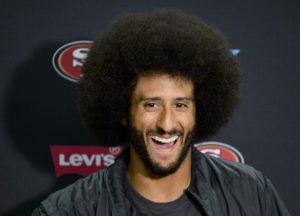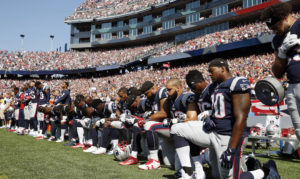NBA Legend Wilt Chamberlain Doesn’t Get the Respect He Deserves
The Hall of Fame center may or may not have been the best player in pro basketball history, but undoubtedly he was the greatest.
Wilt Chamberlain is the only NBA player to score 100 points in an NBA game. (Paul Vathis / AP)
If you drive to the Hersheypark Arena looking for history, as I did, you won’t find a lot—just a small historical marker outside the main gate and, in the lobby, a photo of Wilt Chamberlain holding up a handmade sign with the number “100” written on it. These aren’t much of a testament compared to the event they commemorate.
The Hersheypark Arena (the Hershey Sports Arena when it opened in 1936) is a classic Works Progress Administration project with an arched roof that made it the first arena in the country in which no seat was obstructed by a column. But architectural merits aside, it wasn’t an especially notable venue for the prodigious achievement that took place there on March 2, 1962, when Wilt Chamberlain scored 100 points against the New York Knicks.
The town of Hershey’s web page for the arena shows an exterior shot and a photo of Dwight and Mamie Eisenhower—but there’s not a mention of Wilt’s achievement.
Imagine the equivalent in baseball: Babe Ruth hitting his 60th home run in, say, a minor league park in Trenton, N.J., or maybe Scranton, Pa., in front of a handful of people. No one knows for sure how many fans were in Hershey the night Wilt scored 100 for the Philadelphia Warriors, although modern box scores say around 4,100. Of course, in later years, the number of people who claimed to have been there multiplied several times over.
No one was prepared for what happened that night. The game wasn’t televised. If it wasn’t for an unknown Philadelphia college student listening to a late-night rebroadcast of the game, there would be no surviving account of the game. Sensing after three periods that something momentous was happening, the kid taped the fourth quarter on a reel-to-reel player and later took the recording to the team offices.
Why was the game even played at the Hershey Sports Arena instead of the Philadelphia Civic Center? The Philadelphia Warriors weren’t drawing very well—in fact, until the team moved to the West Coast and evolved into the Golden State Warriors, they never drew well. Management decided to play several games a year in the Pennsylvania sticks in an attempt to increase the team’s fan base.
The arena looks virtually the same as it did 55 years ago, but NBA basketball is no longer played there. It was the home of the Hershey Bears minor league hockey team until 2002, when the team moved to a new facility across the parking lot. Now, the old arena is home ice for the Lebanon Valley College hockey team and the Hershey Junior Bears, a youth team sponsored by the Bears.
It’s also open for public skating. That’s it—no basketball of any kind.
I don’t know exactly what would be an appropriate monument. I’m thinking maybe some sort of bronze statue at least as tall as Wilt himself, something to celebrate not merely what he accomplished that day but what he meant to the NBA.
Wilt Chamberlain (1936-1999) was the Babe Ruth of pro basketball. Like Ruth, he was by far the most dominant force in his time, and quite possibly of all time. But Chamberlain was even more important to basketball than Ruth was to baseball.
Contrary to popular opinion, baseball was doing quite well at the turnstiles when Ruth came along, and the sport would have survived the stink of the Black Sox gambling scandal with or without him. But in Chamberlain’s day, basketball was barely one of the big three pro sports, lagging far behind baseball and football. Without Wilt, who knows whether the NBA would have made it from the slow 1960s to the Magic Johnson-Larry Bird boom of the late 1970s and early 1980s, and the Michael Jordan tidal wave a few years later?
There is a primary difference between the careers of Babe Ruth and Wilt Chamberlain: Ruth was—and is—regarded by most baseball analysts as the greatest player in his game. But basketball people have never quite been able to make up their minds about Wilt.
Back in the mid-1960s, it was common to hear sports fans say things like, “Well, yeah, he scores a lot of points, but it’s just because he’s so big.” Yes, at 7 feet 1, he was big all right, but the comeback should have been, “Yes, and how many clumsy, slow, 7-foot guys are superstars in pro basketball?”
The truly amazing thing about Chamberlain was not his size, but the agility and savvy that propelled him. There are great scorers in the game, and there are great rebounders. Seven times, Wilt Chamberlain led his league in scoring, and 11 times, he led it in rebounding. Today, LeBron James and Stephen Curry dominate the game, but their scoring and rebounding numbers have not approached Wilt’s.
As the NBA takes its All-Star break a little more than halfway through the season, Oklahoma City’s Russell Westbrook leads the NBA in scoring with 31.1 points per game. Miami’s Hassan Whiteside leads in rebounds, averaging 14.1 per game. Over 16 seasons, Wilt Chamberlain averaged 31.2 points and 22.9 rebounds per game. Blocked shots? We don’t know. They didn’t keep that stat for most of Wilt’s career. The reason they started counting blocked shots is because Chamberlain blocked so many.
Actually, there was one more big difference in the careers of Babe Ruth and Wilt Chamberlain: Ruth didn’t face the baseball equivalent of a Bill Russell. A great many basketball fans and analysts argue that Russell was greater than Chamberlain.
There is much to support this argument, but here’s the point that matters most: During the span of Russell’s career, Chamberlain’s teams won a single championship while Russell’s Boston Celtics won nine. When evaluating any athlete’s greatness in a team sport, there is always the question of the supporting cast, and a fair person must concede that the Celtics, man for man, were much better than Chamberlain’s teams. (He spent six years with the Philadelphia and San Francisco Warriors, five with the Los Angeles Lakers and four with the Philadelphia 76ers.)
Russell was one of the greatest in the game, along with Wilt himself. They brought out the best in each other. But Chamberlain was the master. For all intents and purposes, he created the most crowd-pleasing power play—the slam dunk—and he was a shot-blocking specialist.
If he faced bigger, stronger, faster, better-trained and better-coached players, Wilt Chamberlain would not have dominated as he did in the 1960s. If he played today, he would not have scored 40 or more points a game with the same regularity that he did then. And he probably would never have reached 100 in a single game. But it’s hard to imagine anyone coming along today with Wilt’s combination of size, strength, speed and agility.
Chamberlain’s greatness, however, doesn’t need “what ifs?” to validate it. Long before the huge TV contracts and the internet, Wilt Chamberlain kept interest in pro basketball alive and helped the game prevail. He may or may not have been the best player in pro basketball history, but undoubtedly he was the greatest.
With an uncertain future and a new administration casting doubt on press freedoms, the danger is clear: The truth is at risk.
Now is the time to give. Your tax-deductible support allows us to dig deeper, delivering fearless investigative reporting and analysis that exposes what’s really happening — without compromise.
Stand with our courageous journalists. Donate today to protect a free press, uphold democracy and unearth untold stories.






You need to be a supporter to comment.
There are currently no responses to this article.
Be the first to respond.